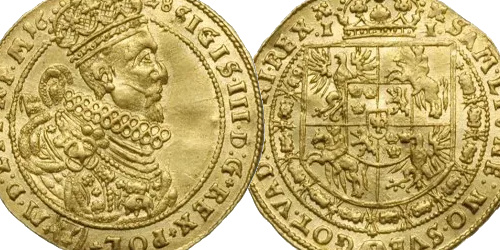Our cover item in the Polish paper money section and at the same time the most beautiful banknote from the period of the Kingdom of Poland that we have hosted on our auctions!
An outstanding five-zloty banknote from the period of the Kingdom of Poland.
A complete and specimen piece in every respect!
An extremely typologically necessary item, being practically the only available denomination of the issue dated 1830. Signature of the bank director Niepokoyczycki.
A rare variety with a two-digit numerator (Serya 25) and at the same time the lowest known serial number listed at auction in Poland. There are only a few known listings of this numerator variety over the last thirty years! The three-digit variety is the most common, and the single-digit variety has not been listed before.
Piece in printer's condition with an unprecedented presence for 19th century Polish banknotes.
Broken horizontally and lighter bent vertically and sparsely within the corners, but without any paper delamination or print rubbing at the break lines. Edges smooth, without cuts. Local rippling of the paper is the result of non-moisture. Piece without any traces of human interference. It is enough to look at the photo under the light to appreciate what an exquisitely preserved piece we are dealing with. The paper is clean, with only a spot of slight discoloration, the printing is contrasting, and the dry stamp is spectacularly preserved - even intact with a clearly outlined double-headed eagle in the rim! A bargain banknote!
Banknote in PMG slab graded PMG 40 (Extremely Fine). This is the highest graded piece in the PMG register. We have carefully reviewed the pieces listed so far, and not including museum pieces, this is the nicest representative of the variety with the signature of Director Niepokoyczycki that has ever been at auction in Poland. We reached one piece equally nice in the Lucow Collection, but with the signature of Lubowidzki.
Banknotes from the period of the Kingdom of Poland of this class are listed once in a collector's generation. The best preserved piece ever listed at auction, with the highest note in the PMG register and in a rare numerator variety with the lowest known serial number. Such preserved and complete banknotes simply do not exist!
We have no doubt that the bidding of this item will heat up the auction room to red-hot!
In 1815, the Kingdom of Poland was established, united by a personal union with the Russian Empire. State separateness was abolished after the fall of the November Uprising. Only administrative separateness was retained. After the January Uprising, it too was abolished.
The idea of introducing paper money in the Kingdom of Poland appeared in 1821. In this way it was wanted to pay off the debts of the governments of the Duchy of Warsaw, which had to be settled by the Central Liquidation Commission. On April 15, 1823, Tsar Alexander I issued a decree under which he established cash tickets in Polish zlotys.
Denominations: 5, 10, 50 and 100 zlotys with the issue date of 1824 were printed at the Assignment Factory in St. Petersburg. Originally, a commission of 2% of their value was to be deducted when they were exchanged for bullion coin. In the end, it was not decided to put them into circulation. This was done only by the Bank of Poland, established in 1828.
After the opening of a bank of issue in the Kingdom of Poland, the total circulation of paper money proved too small. In addition, the tickets printed in 1824 were made on poor-quality paper and were easily damaged. For this reason, tickets with a new design were prepared with an issue date of May 1, 1830. Unlike previous issues of paper money, these tickets won full public trust. Contributing to this was the possibility of permanent and full exchange for bullion money at the bank's cash desks without deducting commissions when exchanging them.
Cash tickets from 1824 were in the form of a lying rectangle surrounded by a decorative frame. Their designs were modeled on Russian asignats. They were the first paper money printed on both sides. At the top, in the center of the frame, there is a circular field with the coat of arms of the Kingdom of Poland. In 1828, new paper money designs were created on which the White Eagle was missing. It can be found on the dry seal of the Bank of Poland as part of the coat of arms of the congressional kingdom.
After the outbreak of the November Uprising, the population hoarded bullion money, which forced the issuance of paper money of low denominations. The national government authorized the Bank of Poland to issue denominations of 1 and 2 zlotys. However, only the lower denomination with the annual date of 1831 was put into circulation. This was the only banknote of the sovereign Polish state in the 19th century.













